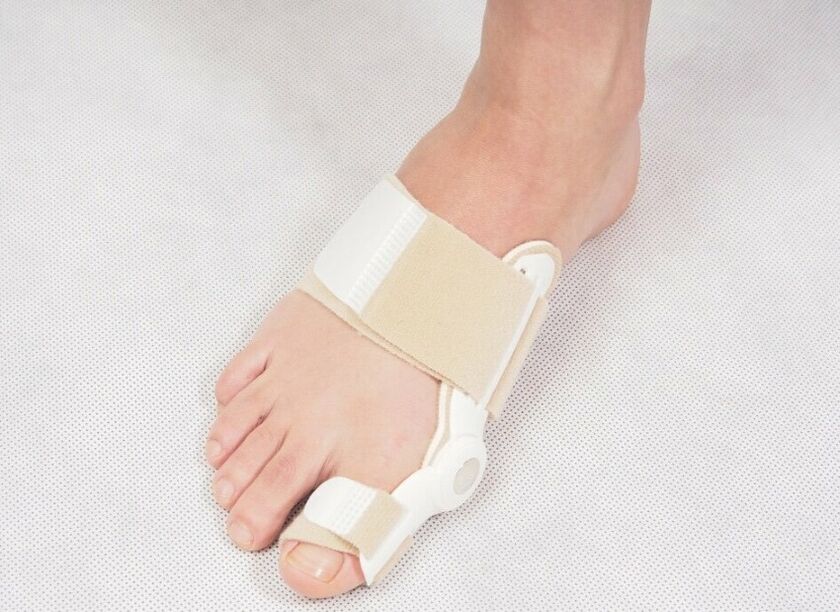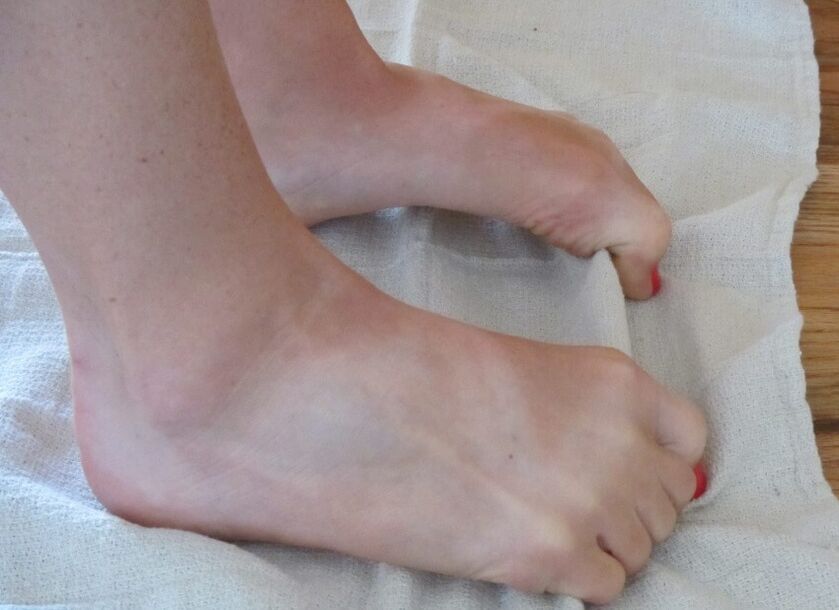Hallux valgus is a common orthopedic condition.Usually treated with surgery.Conservative methods - exercise therapy, massage, physiotherapy, medication - play an important role in the prevention and postoperative rehabilitation of hallux valgus.All the treatment methods for bunions and hallux valgus will be discussed in the article.
What is hallux valgus?
This is a disease in which the big toe moves to the side and bone appears in the area of the ankle joint.The pathology code for hallux valgus according to ICD 10 is M20.1.
Main reasonHallux valgus disease is consideredhereditary weakness of connective tissue.The stimulating factors are:
- wear tight shoes;
- wearing high heels constantly;
- excessive load.
Less commonly, hallux valgus deformity occurs due to developmental defects, trauma, or other diseases.
Degrees of Hallux Valgus and their symptoms
There are several classifications of Hallux valgus, distinguishing 3 or 4 degrees of pathology.The authors of the guide for orthopedists use the following systematization of the stages of hallux valgus:
| Degree | Deformation angle, in degrees | Signs of deformation |
| 1 (weak) | Under 20 | The tumor is not painful.Sometimes a feeling of discomfort appears after a long trip. |
| 2 (average) | 25-35 | Severe curvature, difficulty walking when wearing shoes with narrow heels and toes.Pain, calluses, and recurring arthritis may occur. |
| 3 (severe) | More than 35 | Severe deformity, problems choosing shoes, difficulty standing and walking, changes in gait.Frequent pain, corns, calluses, and accompanying changes in the feet are typical. |

Treatment of hallux valgus deformity of the first toe
The only way to correct severe hallux valgus is surgical correction.Conservative techniques are used mainly in the early stages of deformation.Hallux Valgus is treated by an orthopedist.
The main method of determining the extent of pathology is X-rays, which are taken in two loaded projections.In addition, the doctor may prescribe tomography, CT, MRI and other studies.
Hallux varus correction surgery
Surgical treatment is indicated for moderate to severe hallux valgus deformity.At the patient's request, minor surgery is sometimes performed to remove the cosmetic defect.There are many methods to remove lumps:
- Exostosis excision;
- bone removal;
- tendon transfer according to McBride et al.
The intervention is performed using conventional methods or through percutaneous correction (using small punctures).The growth can be removed with a laser.One or more incisions are made on the side or back of the foot.The cone is cut off, sometimes creating artificial fractures of the main phalanx or first metatarsal, the fragments are fixed with screws.
In the early stages of Hallux valgusThe surgery lasts 30-40 minutes, with severe deformation –up to one and a half hours.
Rehabilitation after hallux valgus removal
Recovery after lump removal lasts about 2 months.The key to full recovery is strict adherence to your orthopedist's recommendations.If the rules of rehabilitation are ignored, complications can develop long after surgery - re-formation of hallux valgus or restriction of movement in the joint throughout life.
What shoes to wear after surgery?
From the second day you are allowed to walk in Baruk's shoes.Before the swelling subsides, you shouldMove around as little as possible, most patients lie with their legs elevated.After 2 weeks, walking restrictions are lifted.The use of Baruk boots remains mandatory for 1-1.5 months after osteotomy.Then you can wear loose sneakers or boots with a wide toe.
You need to give up high heels for six months.
Can I have a massage after surgery?
Massage can be performed after the wound has completely healed.To improve blood circulation and lymphatic drainage, massage the entire lower limb.The procedure begins with stroking.Then knead the soles of your feet and the instep of your feet in a circular motion.Grasp the ankle joint with your hands and move towards the knee.At the final stage, the strokes are performed again.
Foot therapy exercises with screws
Physical therapy is a mandatory part of the rehabilitation phase for Hallux valgus and begins in the third week after surgery.First, bend and straighten your fingers 3 times, holding each position for 10 seconds.Exercises are repeated 3-4 times a day.Every movement is done carefully to avoid causing discomfort.
From the second month after removal of Hallux valgus, the number of repetitions increases to 7-8, the number of approaches - to 6-8 per day.Discomfort is acceptable.Active movements are complemented by passive movements (use of hands).After a month and a half, you need to stand on tiptoes 5-6 times a day, 7-8 times and maintain this position for about 10 seconds.
It is helpful when walking on inclined surfaces and climbing stairs.

Editing tape
Corrective bandages are used after discontinuing use of Baruk shoes.The product consists of two bandages that are connected by a hinge and fix the thumb in an abducted position.After 1-1.5 months, the bandage is replaced with a silicone pad.The legs should not be compressed– This impedes blood circulation and can cause soft tissue damage.
How to get rid of Hallux valgus without surgery
In advanced stages of hallux valgus, bunions cannot be completely cured with conservative treatment.All conservative methods are used only to eliminate pain, prevent complications and progression of curvature.
To ensure resultsTreatment should be started as soon as the first signs appearappearance of hallux valgus.Special exercises, massage, physiotherapy, wearing orthopedic devices combined with the use of folk remedies are all effective.
Massage your feet and big toes
The procedure is recommended to be carried out after a warm bath.
- The leg with the deformed toe is bent at the knee and placed on the thigh of the other leg, the sole of the foot facing inward.
- The sole is kneaded with a fist, alternately pressing on different areas of the distal part.
- The hallux valgus tumor is massaged in circular motions, then all fingers are straightened and kneaded.
- To stimulate blood and lymph flow, wrap your arms around your legs and move your palms from your feet to your knees.
Medicine to treat deformities
To eliminate inflammation in the Hallux valgus area, topical anti-inflammatory drugs are used.
The formation of hallux valgus is accompanied by the development of arthritis and a decrease in local metabolic processes.Therefore, to improve blood flow and stimulate tissue repair, drugs with a cartilage-protective effect are used.
There are special complex ointments against Hallux valgus.For example, a special cream containing shark oil, natural oils and extracts has an anti-inflammatory effect, eliminates pain and stimulates tissue regeneration.
To relieve pain and inflammation, you can use patches, compresses with propolis, burdock and turpentine, red clay and sea salt.All preparations are applied to protruding bones, bandaged, left for 1-2 hours, then washed off.

Can hallux valgus be corrected with exercises?
Exercises for Hallux valgus can strengthen ligaments and muscles, while providing a positive effect on small bones.Gymnastics is performed after warming up the hallux valgus deformity by massage.Do the following exercises:
- Alternate heel-toe walking with support on the outer and inner edges of the foot.
- Walk on a hanging carpet.
- Roll an elastic ball.
- Stretch and compress your toes in a sitting position.
- Take objects (pencils, napkins, small toys).
- Draw many different shapes in the air.
- Stretch the elastic band placed on the big toe by spreading your feet wide.
- Passively flex and extend the affected joint with the hands.
Exercises are performed daily, complete with free stretching and stroking to relieve muscle tension.Only continuous loading can influence the course of the disease.
Orthopedic equipment
Taking into account the material, all devices for Hallux valgus are divided into three groups: soft, semi-rigid, rigid.Soft ones are used during the day, semi-hard ones - up to several hours.The stiffeners are designed to immobilize the feet at night.
Depending on the type of construction, there are:
- Insert between fingers- correction of the position of the first finger in the early stages of the deformity or in the postoperative period.Made from soft silicone.
- Sole pads- Soft product used to improve shock absorption.Sometimes they have a built-in septum that helps eliminate bunions.
- Correction and bandaging tools- recommended for moderate and severe stages.They can be soft or semi-firm and hold a significant portion of the foot.They are also used for valgus feet.
- Orthopedic brace- hallux valgus angle correction.Used in later stages and only at night, as they are not compatible with shoes.
Physical therapy for hallux valgus
Physical therapy procedures are considered part of a comprehensive treatment approach and are consistent with massage and exercise therapy.The following methods are used:
- Paraffin therapy- provides deep warming to muscles and ligaments, improves blood circulation, activates local metabolism.
- Therapeutic mud- has the same effect as paraffin.Reduce muscle tension.
- Laser therapy- helps expand capillaries, reduce swelling and improve cellular protein absorption.
- Ultrasound therapy- activates metabolism and microcirculation in tissues.Stimulates collagen production.Reduces pain and swelling in the hallux valgus area.
- Shock wave therapy— eliminates stagnant processes, stimulates blood flow, improves the supply of oxygen and nutrients and activates regeneration processes.Effectively acts not only on ligaments and muscles, but also on bone and cartilage tissue.
Prevention of hallux valgus
Hallux valgus prevention should start early.Special attention should be paid to the health of children's feet, family has a relative with Hallux valgus disease with bumps on the thumb.Bunions are formed when there is horizontal flat feet, so children and adults with this pathology need to regularly perform exercises to strengthen the ligament-muscle apparatus.
It is important to choose the right shoes - roomy, with a stable sole, made from natural materials.You should give up high heels.It is helpful to wear arch support.If indicated, orthotic insoles should be used.Regular but not excessive physical activity is beneficial.
You should remove excess weight to reduce static load.

























